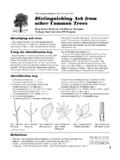Transcription of Trees for Parking Lots and Paved Areas - Home | Food and ...
1 An urban phenomenonParking lots and Paved areasare essential urban featuresthat tend to be unsightly intheir basic form. Municipalordinances often mandatespecific amounts of parkingfor different types of com-mercial or residential landuse, as well as landscapingfor these Parking in and aroundparking lots and pavementimproves appearance, prevents soil erosion, andreduces carbon dioxide through Areas also reduce storm water drainage prob-lems, reduce the detrimental effects of wind and noise,and enhance human comfort by providing heat-reduc-ing Areas pose challengesMany of the urban challenges that Trees face begin withthe construction process.
2 At the beginning of parkinglot construction, topsoil is generally removed. Thesubgrade is then compacted, followed by layers ofcrush and run stone, and asphalt or concrete that arespread and also compacted. If municipal compactionspecifications are adhered to, the resulting soil mixunder the pavement is generally impenetrable to rootsdue to mechanical impediment. It also limits rootgrowth due to low available planted near pavement often suffer due to rootdamage and soil volume restriction. The lateral growthof shallow tree roots causes sidewalks to crack andheave, creating lips or stub-toe spots because ofuneven displace-ment of adjoiningsections of root vs.
3 Pave-ment conflict is oneof the most perva-sive problems inurban and/orreplacement of Trees and repair of Paved surfaces canstrain limited municipal funds. In addition, city gov-ernments may be found liable in damage suits whereinjuries occur as a result of pavement appropriate Trees for Parking lots and otherpaved Areas is challenging. Paved surfaces are engi-neered to quickly shed water, often in directions thateither deprive Trees of ade-quate soil moisture or leavetheir roots submerged inexcess water.
4 Heat fromparking lots and other pave-ment is exacerbated by thesolar heat sink of the pave-ment, with adjacent build-ings and cars adding to thestress. Limited soil volumesconfine roots, restrictingroot growth, reducinganchorage, and often supplying inadequate moistureand nutrients. The stress of compaction and low soilfertility, coupled with other physical, environmentaland human forces acting against Trees makes parkinglots and Paved Areas unfriendly to Trees . These factorscombined make 7 - 10 years the average life expectan-cy of most urban 430-028 Trees for ProblemLandscape Sites VirginiaCooperativeExtensionTrees for Parking lots and Paved AreasBonnie Appleton, Jack Horsley, and Vivian Harris*Gregory Eaton, Laurie Fox, Jim Orband, and Chuck Hoysa**VIRGINIA POLYTECHNIC INSTITUTEAND STATE UNIVERSITYVIRGINIA STATE UNIVERSITYV irginia Cooperative Extension programs and employment are open to all, regardless of race, color, religion, sex, age, veteran status,national origin, disability, or political affiliation.
5 An equal opportunity/affirmative action employer. Issued in furtherance of CooperativeExtension work, Virginia Polytechnic Institute and State University, Virginia State University, and the Department of Agriculture cooperating. J. David Barrett, Director, Virginia Cooperative Extension, Virginia Tech, Blacksburg; Lorenza W. Lyons, Administrator, 1890 Extension Program, Virginia State, *Extension Specialist and Graduate Students, Hampton Roads AREC, Virginia Tech, respectively**Editorial Contributors, Virginia Tech Dept. of Horticulture, Hampton Roads AREC, York County VCE, and Fauquier County VCE, respectivelySelection and plantingrecommendationsUse appropriate tree species.
6 Avoid Trees with largesurface roots that may damage pavement, and treeswith dense canopies that block light penetration to thepavement, preventing rapid evaporation of precipita-tion. Also avoid Trees that can litter the pavement withfruit, branches, and large Trees will beinstalled into park-ing lot islands which create a pseu-do-container forroots, design theseislands with asmuch soil volume aspossible. Ideally,the roots should be able to grow at least to the drip lineor crown edge of the tree at maturity. A soil volume of2 to 3 cubic feet per 1 square foot of crown spread isrecommended.
7 Where soil volumes are restrictive,select smaller tree species or cultivars, or species thatare especially heat and drought tolerant. Plan for the mature size ofthe tree above ground. Besure tree heights will notinterfere with overhead util-ity lines or building over-hangs. Be sure that treespreads will not interferewith pedestrians or vehiclesthat must pass beneath thetrees. In narrow Areas ,upright or columnar culti-vars of Trees may be needed. Follow good planting prac-tices (See VCE Publication430-295 - tree and ShrubPlanting Guidelines).
8 Maintain 2 - 3 inches ofmulch within the drip line ofthe tree , replenishing asneeded. Keep the mulchfrom contacting the treetrunk, and minimize thenumber of competing plantswithin this mulched possible, design permanent drip or pop-upirrigation systems. Restricted root systems, reflectedheat, and dry summers create extreme drought stressfor Trees in parkinglots and other pavedareas. Avoid cuttingtree roots when irri-gation is installedafter Trees are estab-lished. Be sure theamount of irrigationis appropriate forthe tree species because irrigation quantities needed forturf maintenance are generally excessive for if tree growth (pale and small leaves or stunt-ed twigs) and/or soil or plant tissue analyses indicatenutrient deficiencies.
9 Application of a controlledrelease nitrogen fertilizer may be needed every year ortwo if no turf fertilizer is applied and if soil volumesfor root growth are salt tolerant tree species for Parking lots andpaved Areas where deicing salts may accumulate ordrain over tree strategies for Paved areasResearch on tree planting practices has yielded newinformation on reducing stress to urban Trees . Some ofthese practices include the use of root barriers, engi-neered soils, updated pavement repair methods orreplacements, and different methods of tree pit barriers can be used to divert tree roots from side-walks and other Paved Areas .
10 Barriers are made ofeither rigid plastic or herbicide-treated polypropylenefabric. The barriers are placed in vertical soil trenchesbetween the tree and the pavement to divert lateralroots downward. If soil conditions are favorable, mostroots will continue growing laterally at a lower depthalong the barrier, although some may resurface afterthey grow under the and pavement need a firm foundation (com-pact soil) to insure structural integrity. Conversely,compacted soil is a major cause of surface tree rootdevelopment.











